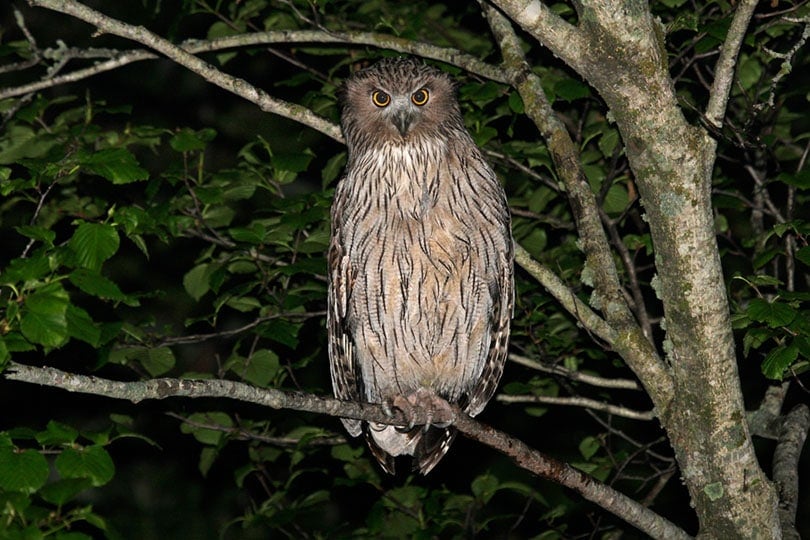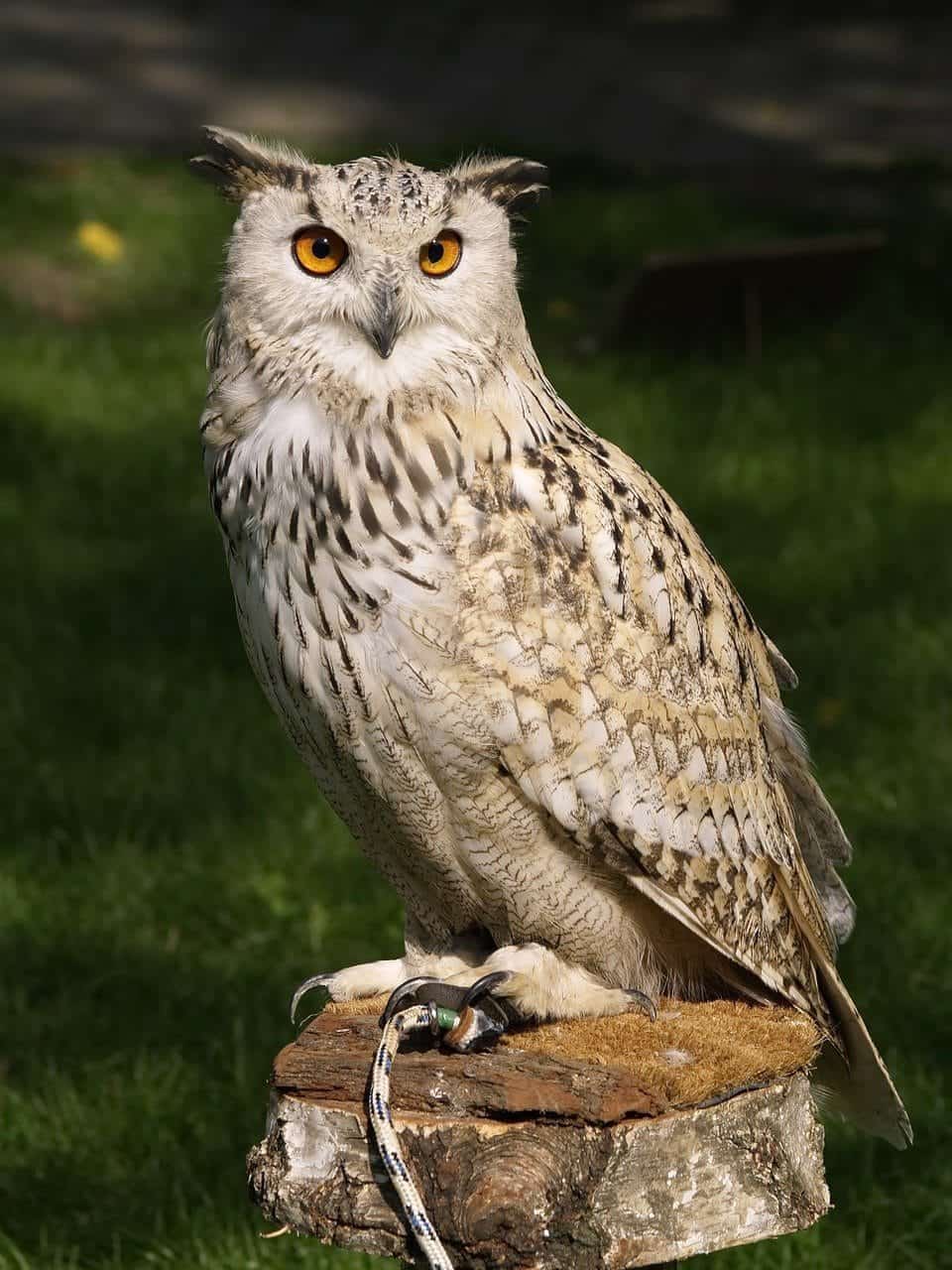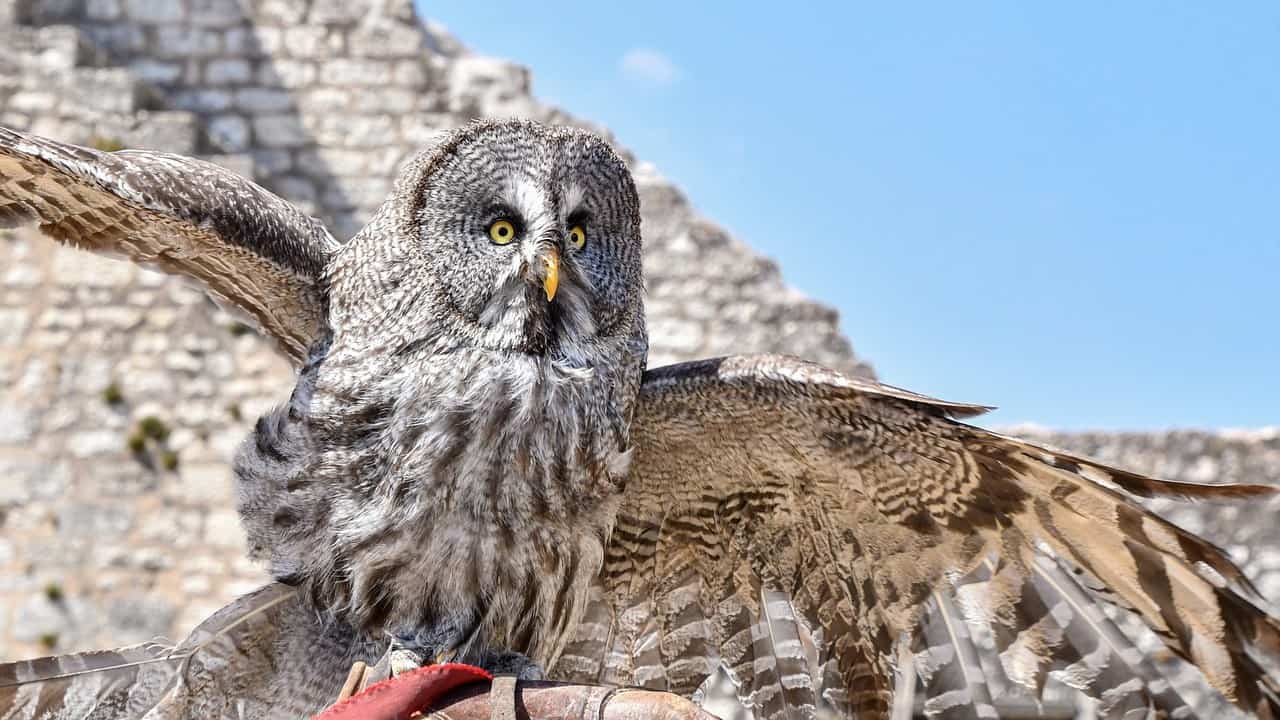When most people think of birds, they imagine delicate little creatures that flap around yards and gardens, much like the Hummingbird, Cardinal, or Blue Jay. Though these breeds are beautiful, majestic, and a great representation of the species, there are many birds that are large and slightly terrifying, both because of their size and piercing qualities. Owls often come to mind.
The owl is an impressive example of large birds, known for its deep and powerful hoot during the night. Being a nocturnal species, owls have feathers that are camouflaged so they can hunt their prey unseen. Though owls can be large or small, the large owls are something frightening yet fluffy, making them seriously attractive predators.
Let’s look at the five largest owls in the world and learn a bit about their life and characteristics.

The 5 Largest Owls in the World
1. Blakiston’s Fish Owl

- Weight: 6–8.8 lbs
- Wingspan: 6.5 feet
- Habitat: China, Japan, and Russia
The biggest owl in the world is the Blakiston’s Fish Owl, which is a subvariety of eagle owl that is not found in many locations. Many conservation efforts have been made to preserve its habitat so that the frighteningly large owl can remain on earth naturally. Being so large, the Blakiston’s Fish Owl is one of the rarest bird breeds, and it certainly isn’t something to mess with.
Their Look
The Blakiston’s Fish Owl has a unique look. It is incredibly massive, with rounded ear tufts at the top of the head that can be relaxed. Its face includes a facial disc, but the facial disc does not have a distinct rim like other breeds. The chin is white while the rest of its body is brown with blackish-brown colorations.
This bird is enormous, which is why it is number one on our list. The female Blakiston’s Fish Owls are normally larger than the males, but both are big. Their size allows them to eat a primarily fish diet, hence its name.
Behavior
The Blakiston’s Fish Owl primarily eats fish. Some of these fish are even large, much like a catfish or trout. During the winter months, these birds will also hunt smaller mammals, like hares. They typically hunt right at dark, but they can be active during dusk too. Most of the Blakiston’s Fish Owl’s time is spent on the ground.
One thing that makes this breed stand apart, aside from its huge size, is its song. The owl’s song is very unique, with a deep sound. It is often given in a duet, but it can be sung alone too. The duet will include three notes. The first two come from the male, and the third comes from the female. The female note will overlap the second male note.
Habitat
Blakiston’s Fish Owls are primarily found in riverine and coniferous forests. They specifically stay around areas where the fast-flowing rivers remain partially ice-free during the winter, allowing them to hunt their ideal prey—fish. Because of deforestation, their habitats are being destroyed, which is why conservation efforts have been made to preserve this breed’s natural habitat.
2. Eurasian Eagle Owl

- Weight: 6–8 lbs
- Wingspan: 5–6 feet
- Habitat: Asia, Europe, and Northern Africa
The runner up for the largest owl in the world is the Eurasian Eagle Owl. This owl has a very terrifying and striking look, complete with noticeable ear tufts, feathered talons, and potentially red eyes. These birds are incredibly large and have powerful hunting abilities.
Their Look
Eurasian Eagle Owls have a facial disc that frames the face. It is a buff coloration with brown and black speckles. At the top of the head are very prominent ear tufts. From the chin to the center of the upper breast, the owl has a white belly. The rest of the body is speckled with dark colors.
Another unique characteristic of its look is eye color. Whereas many owls have yellow eyes, this one can have golden-yellow or orange-red eyes, making them look slightly demonic at times. The bird as a whole is gigantic, both in wingspan and weight.
Behavior
These owls are primarily active between dusk and dawn. When they fly, the flight is silent. These large birds will sometimes even soar or glide over long distances. Eurasian Eagle Owls will typically roost during the day, both single or in pairs, in trees or rock crevices.
One thing that’s unique about the Eurasian Eagle Owl is that every adult has a different vocalization. This means that you can determine which owl you hear just by listening to its voice.
Habitat
The Eurasian Eagle Owl can be found in a variety of habitats, ranging from cooler forests to warm deserts. They prefer rocky landscapes, though. You can find them all over Europe, the Middle East, and Northern Asia.
3. Great Grey Owl

- Weight: 2.5 lbs
- Wingspan: 5 feet
- Habitat: North America
The Great Grey Owl has a large wingspan, but it is notably lighter than many other large owl breeds. It has a very distinctive look, complete with a round head and silvery-gray patterning. You can expect to find these tall birds in dense forests.
Their Look
The adult Great Grey Owl has an overall silvery-gray look and rounded head. It is patterned with brown, gray, and white streaking. You can see a white “bow tie,” complete with a black center, across its neck. Their most striking feature is the disc look of their head.
These owls are not very heavy, but they are incredibly tall with broad wings. Interestingly, the females are larger than their male counterparts. For a bit of reference for their size, these owls are larger than Great Horned Owls but smaller than Bald Eagles.
Behavior
Great Grey Owls avoid areas with people. You’ll most likely see them at the edge of meadows or by forest openings. They primarily hunt before dawn or dusk. When they do hunt, they fly low to the ground over the meadow or forest floor.
Habitat
You can most likely find a Great Grey Owl in dense forests with pine or fir trees. They especially like forests where there is a small opening or meadow in close range, giving them both easy prey and hidden foliage to hide in. These owls have also been known to live in subarctic swampy forests.
4. Snowy Owl

- Weight: 4.5 lbs
- Wingspan: 4.8 feet
- Habitat: North America and the Arctic
One of the most beautiful owls is the Snowy Owl, thanks to its striking white feathers. Despite its beauty, it is an avid hunter that shouldn’t be messed with. It has even been known to pluck smaller birds from the air. Since this owl is found in snowy regions, it has a striking white camouflage coloration.
Their Look
Snowy Owls have a very unique look since they are native to snowy environments, unlike most other owls that stay in forests. They are primarily white, but some adults will have brown spots speckled throughout the white feathers. Females tend to have more coloration than males. Their yellow eyes are very piercing on the white background.
These birds are quite large. They are slightly larger than a Great Horned Owl, but not by much. Snowy Owls have rounded heads and a bulky body. Their legs are especially thick with feathers to keep them warm in cold environments.
Behavior
Snowy owls tend to hunt closer to the ground and in wide-open areas since their native tundra environments lack trees and other foliage. While hunting, they perch on things like fence posts or hay bales. They typically fly close to the ground instead of high up in the air.
Habitat
Snowy Owls breed in the Arctic tundra, but you can often find them around lakes, oceans, and agricultural fields during the deep winter.
- Related Read: 18 Largest Reptiles in the World (with Pictures)
5. Great Horned Owl

- Weight: 3.2 lbs
- Wingspan: 4.6 feet
- Habitat: North America, South America, and the Arctic
Finally, the fifth-largest owl in the world is the Great Horned Owl. This large breed is exactly what you imagine when thinking of a storybook owl, complete with fluffy feathers and a deep hoot. Despite its storybook look, it is incredibly large and a great hunter. You can easily identify these owls because of their interesting ear tufts. Unlike the other breeds, the Great Horned Owl is really common.
Their Look
The Great Horned Owl, as you might have guessed, is named after its most identifiable feature: ear tufts that look much like horns on the top of their head. Another unique feature of the great horned owl is that it has yellow eyes. Even from a distance, you should be able to notice the color.
The rest of their body is rather camouflaged, allowing them to be great hunters. Their color pattern is typically a gray-brown, but they often have reddish-brown faces and a white patch around the throat. The exact color tone of a Great Horned Owl will depend on the region it is from.
As for the size, the adult Great Horned Owl is going to be between a Crow and a Goose. It is slightly larger than a Red-Tailed Hawk for reference. This makes them a pretty large species that is capable of taking down small mammals.
Behavior
Great Horned Owl are great hunters and look for their prey at night. Unless you’re out and about in the dark, you will most likely only see them at dusk. They may sit on different posts or limbs to have access to an easy vision for hunting. You likely have heard their hoot, which is deep and repeated four to five times.
Habitat
The Great Horned Owl can actually be found in many locations. You will typically find them in young woods, but you could also find them around tundra edges, the desert, or a rainforest, making them one of the most adaptable owl species. These owls have also been known to be spotted in cities, suburbs, and orchards.

Conclusion
There you have it! Now you know about the largest owls out there: the Blakiston’s Fish Owl, the Eurasian Eagle Owl, the Great Grey Owl, the Snowy Owl, and the Great Horned Owl. All these owls are large and impeccable hunters, meaning you should not mess with them.
More than their frightening size and predatorial abilities, you shouldn’t mess with them because many are rare or endangered. Given that we are taking a lot of their natural land through deforestation, we shouldn’t do anything to make their situations worse! Enjoy watching their impressive size and beauty from afar.
Looking for additional avian reads? Check out these!
Featured Image Credit: Pixabay
